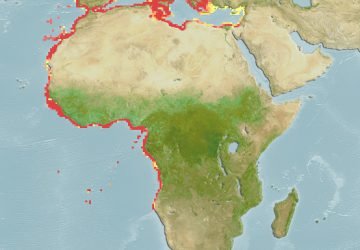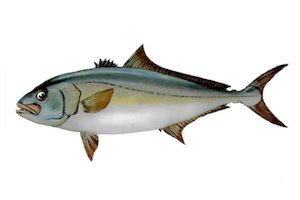Epinephelus Caninus
– Dogtooth Black Grouper –


| State of conservation |
|---|
| Insufficient data [1] |
| Scientific classification |
Epinephelus caninus (Valenciennes, 1843)
| Domain | Eukaryota |
|---|---|
| Kingdom | Animalia |
| Sub-kingdom | Eumetazoa |
| Phylum | Chordata |
| Subphylum | Vertebrates |
| Superclass | Gnathostomata |
| Class | Actinopterygii |
| Subclass | Osteichthyes |
| Superorder | Acanthopterygii |
| Order | Perciformes |
| Suborder | Percoidei |
| Family | Serranidae |
| Subfamily | Epinephelinae |
| Gender | Epinephelus |
| Species | E.CANINO |


Description
The gray grouper is a fish with an oval body, massive and robust, whose size can reach 160 cm (100 to 120 cm on average) for a weight of 57 kg.
Its coloration is silver to brown , sometimes with 4 to 5 darker broad vertical bands . Two darker oblique lines, still visible, start from the eye towards the operculum. It has a massive head with prominent eyes and 3 well marked opercular spines. Its mouth is very wide , slightly pointed, and the lower jaw is prominent. The canines are sometimes visible , especially when looking at this grouper from the front.
The dorsal fin consists of 11 spines and 13-14 soft rays. The caudal fin is truncated , but never concave. The posterior part of the dorsal fin, caudal and anal (3 spines and 8 soft rays) are edged in white .
The scales are cycloid *. There are 70 to 79 along the sideline.
Biotope
Epinephelus caninus frequents rocky areas on sandy or muddy bottoms, 30 to 400 m deep. The young live in shallower water and are more likely to be observed by divers. This species has also been observed on several occasions in artificial reefs in Golfe Juan, Ibiza (Spain) and Loano (Italy).
Similar Species
There are several other species of grouper on our coasts.
The most common is the brown grouper, Epinephelus marginatus : less pointed head, rounded tail, brownish coloring sometimes dark gray to light gray, with irregular light spots. Large individuals are uniform brown and can most easily be confused with E. caninus , but they never have the 2 dark slanting lines from the eye to the operculum.
The other species are rarer on our coasts.
- Polyprion americanus , common cernier or basque grouper: It is present throughout the Mediterranean (rare), the East Atlantic (rare beyond the Bay of Biscay) and West (more northern). It is large (80 cm, maximum 200 cm), with a massive head with a slightly concave upper profile, a strong horizontal bony crest at the top of the operculum and very prominent mandibles. Adults live in depth; only the young are observed near the coast, generally under floating and / or drifting objects. Sightings of young cerniers are not uncommon off our coasts, particularly in the Var. Confusions are therefore unlikely due to the different habitat.
- Mycteroperca rubra , king grouper or red badeche: it is found throughout the Mediterranean, the central eastern and western Atlantic. It is smaller than E. caninus (20 to 40 cm, maximum 80 cm), with a truncated tail, a dark reddish-brown back and paler flanks with dark wavy lines. The red badeche is solitary and frequents sandy and rocky bottoms. This grouper behaves differently from other Epinephelus species: individuals are more often seen above the bottom or in open water, while other Epinephelusstand near the bottom. This species seems to become more frequent along the French coasts, in particular in Corsica where the species has been regularly observed since 2008 or 2009. Very recently (March 2010), Mycteroperca fusca , was captured on the Israeli coasts. This species, native to the Atlantic (Azores, Madeira, Canaries, Cape Verde) has not been observed elsewhere in the Mediterranean despite a probable entry through Gibraltar. Confusion with M. rubra is one possible explanation for this lack of prior signaling.
- Epinephelus costae , badèche grouper: it is a Mediterranean species but exceptional on the Provençal and Catalan coast. Large (30 to 70 cm, maximum 140 cm), it has a fairly elongated body with a truncated caudal or concave edge in adults. It is yellowish brown to sepia brown with a series of darker longitudinal lines on the body and 2 dark, oblique lines on the operculum (young). In addition to old records of E. costae in the Nice region made by Risso at the end of the 19th century, recent observations date from the end of the 1980s in the Port-Cros national park, in the Scandola nature reserve in Corsica and more recently in the Côte Bleue Marine Park.
- Epinephelus aeneus , white grouper: exceptional on the French coasts, it is more frequent in the south of the Mediterranean. It is supposed to be present on the Atlantic coast as far as the British Isles.
Alimentation
The gray grouper is carnivorous. It feeds on fish, crustaceans and molluscs.
Reproduction
Epinephelus caninus is a hermaphrodite * protogynous * species first female then male. Reproduction takes place from March to August. Fertilization is external and the eggs are pelagic.
Various Biology
In comparison with Epinephelus marginatus and E. aeneus , the biology of E. caninus is very poorly understood, probably due to its lower commercial interest (at least in the Mediterranean) or its more extensive distribution.
Further Information
The longevity of this species is important. A 55-year-old man was captured in Mallorca in 2003.
Most groupers around the world are of significant commercial interest. They are often fished in excess and their populations are declining. To compensate for this phenomenon, several countries have embarked on the breeding and rearing of groupers.
In the Mediterranean, breeding trials for Epiphephelus caninus have been attempted but do not seem conclusive.
The gray grouper is fished in the Mediterranean and on the African coasts. It is particularly present on the markets in Senegal.





























































































































































































































